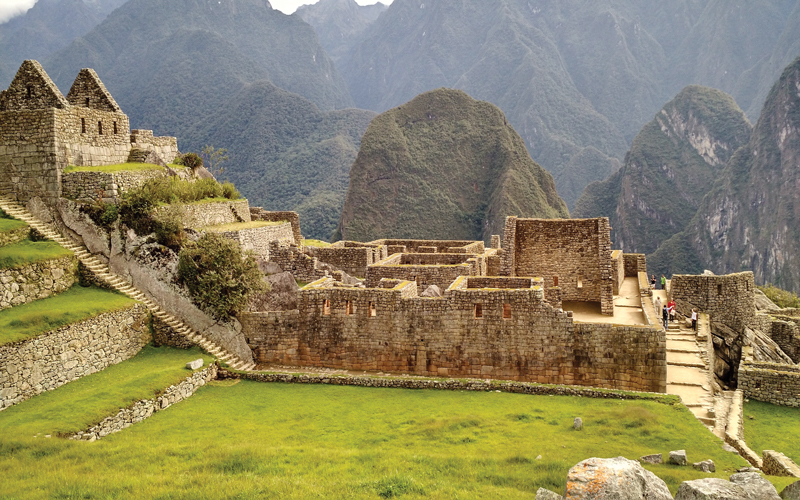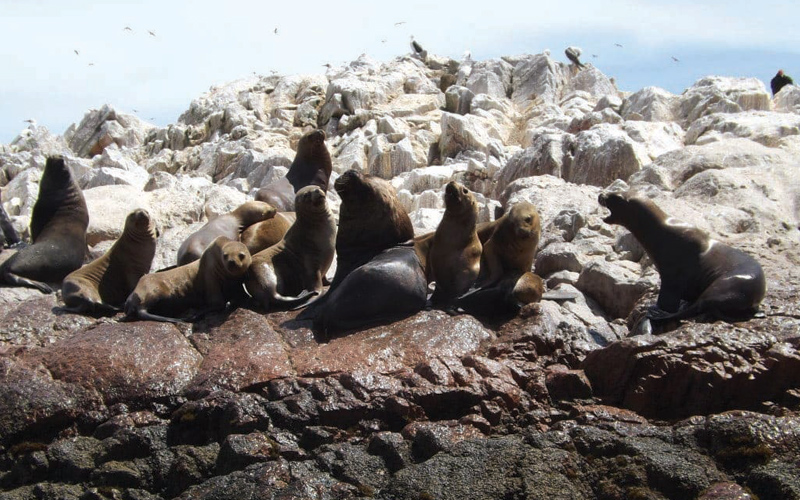Machu Picchu and Beyond
The Inca Trail is one of the world’s most highly sought-after treks,

a 26-mile hike (typically done in four days) that culminates at Machu Picchu, arguably the most spectacular architectural feat of the late Inca Empire. Discovered by American explorer Hiram Bingham, the trail to the “lost city” is well tracked today, while plenty more discoveries await in other parts of the Urubamba Valley.
Arrivals and Making Connections
Travelers visiting Peru typically arrive in Lima, with the majority arriving during the day with no possibility of same day connections to other domestic destinations, forcing travelers to spend at least one night in the city. Although there are attractions that are worth checking out, Lima tends to be a one-day affair for most travelers. Things to do include visiting the Plaza de Armas, Larcomar overlooking the ocean, the Huacapucllana, Inca ruins, museums and Barranco, an older section of the city overlooking the ocean and lined with restaurants.
The domestic flight to Cuzco is about two and a half hours long with breathtaking views of the Andes and lands in the capitol of the Incan Empire. Cuzco is vibrant city with a very unique blend of Spanish and ancient Incan and Quechuan culture that can be seen in its architecture, artwork and music. The cobblestone streets and sidewalks connecting Cuzco’s many parks and plazas wind through the adobe buildings that the conquering Spaniards constructed on top of Incan stone foundations.
Outside the airport there are registered taxis that will take you anywhere in the city or Sacred Valley. The Plaza de Armas is about 10 minutes from the airport and offers a central location for all restaurants, accommodations, and tours in Cuzco and the surrounding area. There are a number of tourist agencies with English speaking guides that offer package deals to all of the archeological sites, The Sacred Valley of the Inca, Machu Picchu, and the Amazon jungle.
There is an abundance of accommodation options around the center of Cuzco including five star and boutique hotels, along with a range of hostels. San Blas is a neighborhood located just a few blocks above the plaza with narrow winding cobblestone roads and terraced housing as it climbs up the side of the valley. It is also an epicenter for backpackers, artists, and alternative Peruvian culture with many shops, cafes and bars hosting live music almost every night of the week.
Just off the plaza is the Avenida del Sol, which has banks, Internet cafés, artisan markets and convenience stores for all travel necessities. The religious site and museum of Koricancha, or Temple of the Sun, is very sacred for both the Incas and Spanish and demonstrates the fusion of these two cultures. Located nearby is the famous twelve-angled stone, fixed into the foundation of a building. The San Pedro market, a short walk from the plaza, is a local open air market that sells the best and cheapest selection of local produce, meat, cheese, breads, herbal medicines and other local crafts.
Archeological Sites Around Cuzco
Sacsayhuaman is located just above the city, a 30-minute uphill walk or ten-minute taxi ride, and is one of the most spectacular archeological sites in the area. Huge stone terraces with single stones measuring over 25 ft. tall and 70 ft. long are placed together with such precision that even a piece of paper cannot penetrate the joints. It also offers beautiful views of the city and surrounding valley. Other archeological sites in the area include Temple of the moon, Qenqo, Puca Pucara, and Tambomachay.
The Road to Machu Picchu
There are a few different ways to get to Machu Picchu from Cuzco. The most direct way is to take the train from Cuzco to Aguas Calientes, the small town located at the base of the mountain were Machu Picchu is located. The other option is to take a bus through the Sacred Valley and then catch the train in Ollantaytambo. Ollantaytambo is also accessible by bus or taxi direct from the city of Cuzco in about 2 hours by taking the road through Urubamba. The town is located at the intersection of three valleys each leading to Machu Picchu, the Sacred Valley and the Amazon Jungle making it an important location and site of the Temple of the Winds.
The train ride from Ollantaytambo is about two and a half hours and has its first departure very early in the morning to accommodate travelers who only have one day to do a round trip visit to the ruins. Two or three days at Machu Picchu will provide time to experience its wonder in a much calmer fashion. From the town of Aguas Calientes, the drop off point for the train, buses depart frequently for the 30-minute drive up a switchback road to the site’s entrance. If time permits, try the hike to Huayna Picchu, a steep climb up stone stairways to a ceremonial site offering views of Machu Picchu and the surrounding mountains. There are two group departure times, each with only 200 permits, so plan accordingly.
The town of Aguas Calientes provides little more than a place to eat and sleep after visiting the ruins. However, it does have natural hot springs at the edge of town that can aid in relaxation after a long day. The Sacred Valley of the Incas
The Sacred Valley of the Incas is located about one and a half hours in the bus or one hour in a taxi from Cuzco. It is a beautiful drive that winds through small alpine villages, corn fields and alpaca herds all above 12,000 ft. and then drops back down with views of sacred mountains, some of which are covered in snow year round. Pisaq is a small town full of restaurants, hostels and backpackers, but still manages to hang on to its traditional culture and charm. In the main plaza there is a craft market three times a week and a more elaborate Sunday market that includes agricultural and handmade products from local mountain villages nearby. There are also spectacular ruins accessible on foot or taxi at the top of the mountain at the edge of town. The ruins can also be partially seen from the main plaza. Ollantaytambo is another two hours along the Urubamba River and through the Sacred Valley dotted with small towns, archeological sites and dramatic scenery. For more information, visit www.peru.travel




